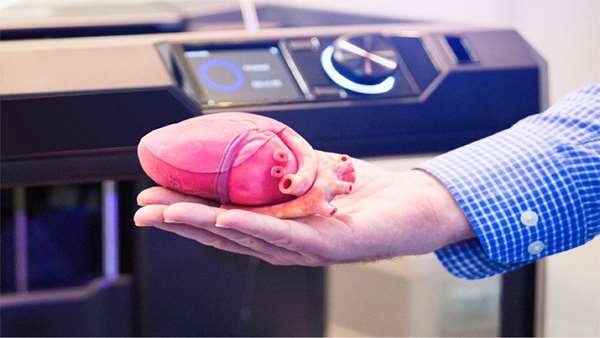Directly printing 3-D tissues within the body
In the TV series Westworld, human body parts are built on robotic frames using 3-D printers. While still far from this scenario, 3-D printers are being increasingly used in medicine. For example, 3-D printing can be used to produce parts of the body such as orthopedic joints and prosthetics, as well as portions of bone, skin and blood vessels.
In the TV series Westworld, human body parts are built on robotic frames using 3-D printers. While still far from this scenario, 3-D printers are being increasingly used in medicine. For example, 3-D printing can be used to produce parts of the body such as orthopedic joints and prosthetics, as well as portions of bone, skin and blood vessels. However, the majority of these tissues are created in an apparatus outside of the body and surgically implanted. Such a procedure may involve making large surgical incisions, posing the added risk of infection and increased recovery time for the patient. And since there is a time lapse between when the tissue is created and when it is implanted in the patient, further complications may occur. To prevent these complications, a team of scientists have developed a technology to print tissues directly in the body.
There are two basic components needed to produce an engineered tissue: (1) a fluid-like "bio-ink" that consists of a framework material mixed with living cells, and (2) growth factors to help the cells grow and develop into regenerated tissue. When developing tissues for direct implantation into the body, there are other things to consider: the construction of tissue would have to be conducted at body temperature (37°C), the tissue needs to be attached effectively to soft, live organ tissue and any procedural steps should not be harmful to the patient. One such harmful step in current methods is the application of harmful UV light necessary to solidify the constructed tissue.
A collaboration among Ali Khademhosseini, Ph.D., Director and CEO of the Terasaki Institute, David J Hoelzle, Ph.D., from the Ohio State University Department of Mechanical and Aerospace Engineering and Amir Sheikhi, Ph.D. from the Pennsylvania State University Department of Chemical Engineering, has produced a specially-formulated bio-ink designed for printing directly in the body.
"This bio-ink formulation is 3-D printable at physiological temperature, and can be crosslinked safely using visible light inside the body." said first author Ali Asghari Adib, Ph.D. In order to build the tissue, they used robotic 3-D printing, which uses robotic machinery affixed with a nozzle. Bio-ink may be dispensed through the nozzle, much like an icing tube squeezes out writing gel, only in a highly-precise, programmable manner.
The team also worked on methods to attach pieces of the tissue formed with this bio-ink onto soft surfaces. In experiments attempting to attach the tissue onto pieces of raw chicken strips and agarose, the team employed a unique interlock technique using the robotic 3-D printer and their specially-formulated bio-ink. The nozzle tip was modified to be able to penetrate the soft surfaces and fill the punctured space with bio-ink as it withdrew; this created an anchor for the tissue construct. As the nozzle tip reached the surface, it dispensed an additional blob of bio-ink to "lock in" the anchor. "The interlocking mechanism enables stronger attachments of the scaffolds to the soft tissue substrate inside the patient body," said Asghari Adib.
Such improvements in tissue engineering are instrumental in providing lower-risk, minimally-invasive laparoscopic options for procedures such as the repair of tissue or organ defects, engineering/implanting patches to enhance ovarian function, or creating bio-functional hernia repair meshes. Such options would be safer for the patient, save time and be more cost-effective. Further modifications in tissue engineering design and the adjustment of other conditions may increase the potential for customization, thus leading the way to limitless possibilities for enhancing patient health.
"Developing personalized tissues that can address various injuries and ailments is very important for the future of medicine. The work presented here addresses an important challenge in making these tissues, as it enables us to deliver the right cells and materials directly to the defect in the operating room," said Khademhosseini, "This work synergizes with our Personalized Implant Technology Platform at the Terasaki Institute which aims to develop approaches that address the variability in tissue defects in patients."
Reference:https://medicalxpress.com/news/2020-06-d-tissues-body.html




ارسال به دوستان